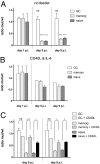AP-1 homolog BZLF1 of Epstein-Barr virus has two essential functions dependent on the epigenetic state of the viral genome
- PMID: 20080764
- PMCID: PMC2818922
- DOI: 10.1073/pnas.0911948107
AP-1 homolog BZLF1 of Epstein-Barr virus has two essential functions dependent on the epigenetic state of the viral genome
Abstract
EBV, a member of the herpes virus family, is a paradigm for human tumor viruses and a model of viral latency amenable for study in vitro. It induces resting human B lymphocytes to proliferate indefinitely in vitro and initially establishes a strictly latent infection in these cells. BZLF1, related to the cellular activating protein 1 (AP-1) family of transcription factors, is the viral master gene essential and sufficient to mediate the switch to induce the EBV lytic phase in latently infected B cells. Enigmatically, after infection BZLF1 is expressed very early in the majority of primary B cells, but its early expression fails to induce the EBV lytic phase. We show that the early expression of BZLF1 has a critical role in driving the proliferation of quiescent naïve and memory B cells but not of activated germinal center B cells. BZLF1's initial failure to induce the EBV lytic phase relies on the viral DNA at first being unmethylated. We have found that the eventual and inevitable methylation of viral DNA is a prerequisite for productive infection in stably, latently infected B cells which then yield progeny virus lacking cytosine-phosphatidyl-guanosine (CpG) methylation. This progeny virus then can repeat EBV's epigenetically regulated, biphasic life cycle. Our data indicate that the viral BZLF1 protein is crucial both to establish latency and to escape from it. Our data also indicate that EBV has evolved to appropriate its host's mode of methylating DNA for its own epigenetic regulation.
Conflict of interest statement
The authors declare no conflict of interest.
Figures




Similar articles
-
The lytic phase of epstein-barr virus requires a viral genome with 5-methylcytosine residues in CpG sites.J Virol. 2012 Jan;86(1):447-58. doi: 10.1128/JVI.06314-11. Epub 2011 Oct 26. J Virol. 2012. PMID: 22031942 Free PMC article.
-
BZLF1 governs CpG-methylated chromatin of Epstein-Barr Virus reversing epigenetic repression.PLoS Pathog. 2012 Sep;8(9):e1002902. doi: 10.1371/journal.ppat.1002902. Epub 2012 Sep 6. PLoS Pathog. 2012. PMID: 22969425 Free PMC article.
-
CpG-methylation regulates a class of Epstein-Barr virus promoters.PLoS Pathog. 2010 Sep 23;6(9):e1001114. doi: 10.1371/journal.ppat.1001114. PLoS Pathog. 2010. PMID: 20886097 Free PMC article.
-
Human B cells on their route to latent infection--early but transient expression of lytic genes of Epstein-Barr virus.Eur J Cell Biol. 2012 Jan;91(1):65-9. doi: 10.1016/j.ejcb.2011.01.014. Epub 2011 Mar 29. Eur J Cell Biol. 2012. PMID: 21450364 Review.
-
Epigenetic lifestyle of Epstein-Barr virus.Semin Immunopathol. 2020 Apr;42(2):131-142. doi: 10.1007/s00281-020-00792-2. Epub 2020 Mar 30. Semin Immunopathol. 2020. PMID: 32232535 Free PMC article. Review.
Cited by
-
The effect of Epstein-Barr virus Latent Membrane Protein 2 expression on the kinetics of early B cell infection.PLoS One. 2013;8(1):e54010. doi: 10.1371/journal.pone.0054010. Epub 2013 Jan 8. PLoS One. 2013. PMID: 23308294 Free PMC article.
-
Herpesvirus Late Gene Expression: A Viral-Specific Pre-initiation Complex Is Key.Front Microbiol. 2016 Jun 6;7:869. doi: 10.3389/fmicb.2016.00869. eCollection 2016. Front Microbiol. 2016. PMID: 27375590 Free PMC article. Review.
-
Epstein-Barr virus and host cell methylation: regulation of latency, replication and virus reactivation.Curr Opin Virol. 2013 Jun;3(3):260-5. doi: 10.1016/j.coviro.2013.03.005. Epub 2013 Apr 6. Curr Opin Virol. 2013. PMID: 23567077 Free PMC article. Review.
-
Micro RNAs of Epstein-Barr virus promote cell cycle progression and prevent apoptosis of primary human B cells.PLoS Pathog. 2010 Aug 19;6(8):e1001063. doi: 10.1371/journal.ppat.1001063. PLoS Pathog. 2010. PMID: 20808852 Free PMC article.
-
Epstein-Barr virus LF2 protein regulates viral replication by altering Rta subcellular localization.J Virol. 2010 Oct;84(19):9920-31. doi: 10.1128/JVI.00573-10. Epub 2010 Jul 14. J Virol. 2010. PMID: 20631124 Free PMC article.
References
-
- Kieff E, Rickinson AB. In: Fields Virology. Knipe DM, et al., editors. Philadelphia: Lippincott - Williams & Wilkins; 2007. pp. 2603–2654.
-
- Young LS, Rickinson AB. Epstein-Barr virus: 40 years on. Nat Rev Cancer. 2004;4:757–768. - PubMed
Publication types
MeSH terms
Substances
Grants and funding
LinkOut - more resources
Full Text Sources
Other Literature Sources
Research Materials

